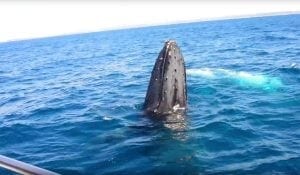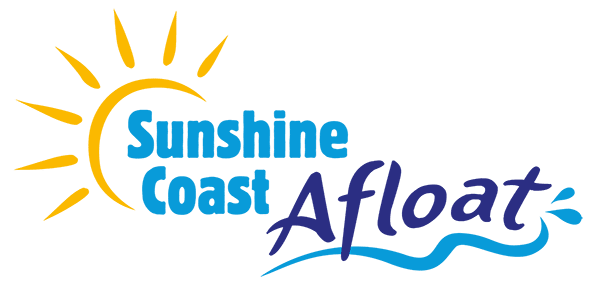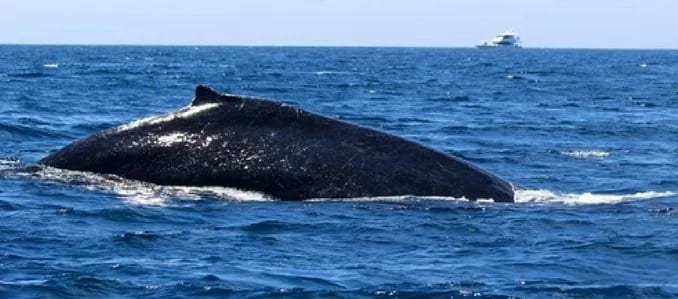The first Humpback whales have been sighted, on their way north to the Sunshine Coast!
Whale Watching out of Mooloolaba, on the Sunshine Coast, approximately one hour north of Brisbane, is rapidly becoming the go-to-place to interact with Humpback whales. It offers several different types of whale watching options. Mooloolaba in particular caters from attracting the masses on Whale One to the intimate, small group options offered by us at Sunshine Coast Afloat. And of course it is also the hub of “swimming with the whales” with Sunreef Mooloolaba. There are just so many options to choose from, all so close to Brisbane.
Our trips are based on the experience we work hard on to be able to give our guests. Small passenger numbers with almost everything included in the price. The complete goal is to provide extremely intimate, almost private, tours with personalised service. The small passenger numbers enables us to ensure all customers always enjoy rail-side viewing of the whales, and of course other marine life.
At Sunshine Coast Afloat we offer two different ways to experience the thrill of whale watching:
- a relaxing cruise with no more than 22 other passengers on one of the largest charter vessels on the Sunshine Coast,
- or if you are more inclined for fast and exhilarating fun, head out on Hela-Va Jet which only takes 10 people.
2016 was an amazing whale watching season. So much so that we are now all anxiously awaiting the arrival of the whales here on the Sunshine Coast this year. A few have already been spotted in NSW, and given that, it will be only a few weeks before we will start to see them up here. In very small numbers at first, but it is always so special to see the first, obviously keen, whales heading North! For us these first whales are almost always spotted on our deep sea fishing charter trips. They certainly add a lot of excitement to the lucky passengers aboard on those trips! One mind-blowingly amazing trip, which the whales made unbelievably special, in 2016 was an ashes scattering ceremony. A ver special and emotional send off I am sure the family will always remember with great fondness because of the whales presence that day!

In the past five years, the number of humpback whales making the journey north from their feeding grounds in Antarctica to the warmer tropical waters of the Pacific to breed has risen from 18,000 to more than 22,000. It is estimated that we are looking at around 25,000 humpbacks this year. More whales mean more pods travelling closer together, more social interactions, antics and action for us to all see and enjoy.
Humpback whales travel from their feeding grounds in Antarctica, past New Zealand, through the Tasman Sea, towards Sydney and up to north Queensland where they begin popping up for people to see. This round-trip is about 12,000 kilometres. The Humpback whales migrate north between May and August. The whales and calves then make the return journey south between August and November. The best time to see these majestic creatures off the Sunshine Coast is between July to end of October. The warmer waters allow juveniles, who are born without blubber for insulation, to mature before dealing with the icy southern water.
Sunshine Coast Afloat commence our Whale Watching trips once we are confident there are large enough number of whales around. This as we want to make sure, as best we can of course, that this is a whale watching trip and not a “whale searching” trip. This does mean we start later than, and finish earlier than most other whale watching operators. Other operators usually start in early June, which can be as much as 4 to 6 weeks earlier. Our other charter operation allow us to closely monitor the number of whales sightings on a daily basis. We believe that this is the best way to set a start date. These earl sightings in NSW ma well see us begin a little earlier this ear as well. Fingers crossed! Either wa this blog will always keep you up to date with where we are at.
Some of the interesting facts about these fascinating creatures:
- The average weight of an adult Humpback whale is 45 tonnes, which is about 1000 children together
- An average length of 13 to 17 metres which is about 10 adults lying head to foot.
- The average lifespan is between 45 – 50 years
- Adult Whales can hold their breath under water for over half an hour
- An expelled breath or ‘blow’ that reaches a speed of between 300 – 500 kilometres per hour as it exists through the blowhole.
- The Humpback Whale has two blow holes, one for each lung. Each of its lungs is the size of a small car.
- Humans identify different whales is by their tails. Each whale has different characteristics, just like our fingerprints!
- The Humpback Whale has no teeth instead they have baleen plates, that acts like a giant sieve!
- They also have little or no sense of smell or taste
- They do have very sensitive skin that is easily sunburned
- Remarkable eyes with strong muscles that change the shape of the lens so they can see in the air or underwater.
- Their eye the size of a grapefruit
- Incredible hearing ranging over many kilometres for navigation, communication and finding food
- Pectoral fins that are ten times longer than your arm
- They have a Belly Button as well.
- Calves that are fed daily over 400 litres of rich milk which is the consistency of condensed cream
START PLANING YOUR WHALE WATCHING EXPERIENCE NOW SO YOU AREN’T DISAPPOINTED.
We are family owned and operated, but we also ensure our crew are experienced, dedicated and knowledgeable. They enjoy sharing their passion and are always happy to help and give you the best experience possible.
Sound interesting? Click Here to book or make an enquiry.



